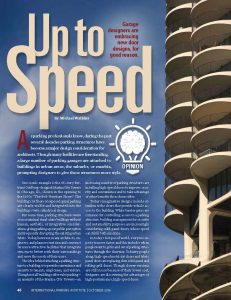UP TO SPEED
Garage designers are embracing new door designs, for good reason.
As parking professionals know, during the past several decades parking structures have become a major design consideration for architects. Though many facilities are freestanding, a large number of parking garages are attached to buildings in urban areas, the suburbs, or exurbia, prompting designers to give these structures more style.
One iconic example is the 65-story Bertrand Goldberg–designed Marina City Towers in Chicago, Ill., shown in the opening to the 1970s “The Bob Newhart Show.” The building’s 19 floors of exposed spiral parking are clearly visible and integrated into the building’s twin cylindrical design.
For some time, parking structures were seen as minimal stand-alone buildings without human, aesthetic, or integrative considerations, giving parking a poor public perception and frequently disrupting the existing urban fabric. Today, however, many architects, engineers,and planners envision and construct far more attractive facilities that integrate structures better with their surroundings and serve the needs of their users.
The idea behind attaching a parking structure to a building is to provide convenience and security to tenants, employees, and visitors. Though not all buildings offer valet parking—an amenity of the Marina City Towers—an increasing number of parking structures are installing high-speed doors to improve security and convenience and to take advantage of other benefits these doors offer.
Today’s imaginative designs include attention to the doors that provide vehicle access to the building. While barrier gates are common for controlling access to a parking structure, building management for security and sustainability purposes are increasingly considering solid-panel doors, whose speed can fulfill both missions.
In today’s fast-paced world, everyone expects to move faster, and this includes when people want to get in and out of parking structures through the doorway. To hurry people along, high-speed metal slat doors and fabric panel doors are replacing slow solid-panel and rolling-grill doors. Though slower versions are still in use because of their lower cost, designers are discovering the advantages of high-performance, high-speed doors.
High-speed doors can open up to five times faster than conventional doors—some models as fast as 100 inches per second. This speed can have significant effect on a number of parking structure access issues.
Security
Parking structures can be more vulnerable to crime than other sorts of buildings. Their low foot-traffic areas, cars, pillars, and recessed areas provide hiding places and offer temptation for those with crime on their mind.
Garage entrance piggybacking can be a problem, enabling intruders to slip into the building behind an authorized vehicle. A slowly operating door adds to the temptation. The longer the door takes to close, the bigger the window of opportunity for unauthorized entrance. Slow doors can be open for many seconds after an authorized vehicle has passed.
Depending on the speed of an entering vehicle and the size of the opening, a high-speed door can be open for just seconds. When the vehicle is clear of the doorway, the building is completely secure. Many high-speed solid panel doors have latching mechanisms at the bottom for an extra measure of security.
Jim Zemski, principal with ZCA Residential, says, “Our firm recommends high-speed overhead doors on all of our urban/residential multifamily garages. This dictates that a high level of security is provided, which is solved by the rapid speed that prevents piggybacking and unauthorized pedestrians from entering the secure garage.”
Sustainability
In Northern-tier states and Canada, a number of attached parking structures provide heating during cold months. At an area of 8 by 10 feet or larger, the doorway provides an ample hole in the wall for air infiltration and costly energy loss. Both parking door speed and design can significantly reduce energy costs. A recent study conducted by the Door and Access Systems Manufacturers Association found that high-speed doors that are accessed frequently would save more energy than heavily insulated doors operating at slower speeds. By cycling in brief seconds, high-speed doors can significantly reduce the loss of heated air.
Once closed, high-speed doors tightly seal the doorway. Doors with anodized aluminum slats have a rubber membrane that covers the connecting hinges; together with a rubber weather seal, this keeps out the elements. This protection combines the seals around the full perimeter of the door, including the door guides that fully enclose the panel’s vertical edges, brush gaskets along the header, and floor-hugging gaskets on the bottom.
Convenience
Americans are always racing to beat the clock, especially in recent years as more demands are placed on their time. People hate to wait to pick up a morning coffee or to get into a parking facility. For people in a hurry, waiting for a slow door to open so they can get into or out of a garage can seem like an eternity. The slow-moving doors at workplace parking facilities can translate into decreased employee productivity. High-speed doors convey a respect for drivers’ time, which adds to the satisfaction with the facility and the business, building owner, or institution associated with it.
Maintenance
Door speed has a significant effect on the door’s useful life and repair costs. The slow speed of conventional doors invites collisions because impatient drivers can rush through the half-opened doorway and clip the bottom of a door that’s not yet fully open. These accidents can
take a door out of action, and worse, damage the car, leading to a very unhappy tenant.
At 60 inches per second or faster, a high-speed dooris too fast for a vehicle to catch up with. At facilities where a driver uses a keypad code and a security card for doorway access, the door is generally fully opened beforethe driver’s foot moves from brake pedal to gas pedal.
Though most high-speed parking garage doors have rigid slats, some facilities are using fabric-panel doors. The fabric-panel doors used at the GID Sovereign at Regent Square project, according to Robert Tullis, vice president and director of design for GID Development, “offer easy repair if they should ever get hit and knocked out of their tracks.”
He notes that his facility maintenance staff can put the fabric doors back in service by simply opening and closing the door, which rethreads the door into its guides. There is no need to call the door repair company, and there are no bent parts to replace. Advanced door controller technology and variable frequency drives on newer doors generate an energyefficient speed curve for smooth motion, soft starting, and soft stopping. These controllers continuously monitor all door activity and cycles and have self-diagnostic capabilities to simplify troubleshooting.
Very few people give much thought to the doors as they enter a parking facility until something goes wrong, either from a security incident or poor door performance. According to Josh Landry with Gables Residential, a developer of high-end multi-unit complexes, “Doors on the parking facility are one of the many items that tenants and owners don’t necessarily think about, but they can be part of the overall positive experience for both tenants and customers.”
MICHAEL WATKINS is vice president of marketing with Rytec Corporation. He can be reached at mwatkins@rytecdoors.com


